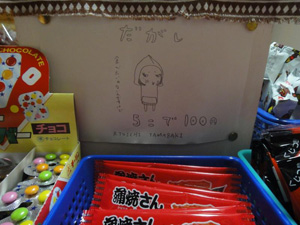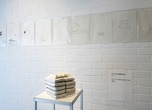
Ryoichi Yamazaki ‘haven’t eaten anything yet’ 2010
Posted: Fri May 28 2010
Hikikomori, a cultural phenomenon wherein adolescents and young adults flat out refuse to emerge from their rooms, is perhaps the result of the internet, ineffective parenting, or maybe just an increasingly complicated world. The hikikomori currently residing at the Nakaochiai Gallery, on the other hand, are entirely the product of artist Ryoichi Yamazaki.
His ‘Culture-bound Syndrome’ series is made up of smaller-than-life sculptures, plus some drawings, of androgynous children cloaked in white, their ghostly pale faces seeming simultaneously dejected, defensive, and imploring. This exhibition, sub-titled ‘Do you remember me?’ is the 5th in the series and the 30-something artist’s first solo at Nakaochiai. This site-specific installation also marks the first time for the gallery to open up its entirety to the public and the result is a positive synergy between the space and the works.
Whereas a traditional gallery setting might cast an exaggerated sense of disengagement on Yamazaki’s work – the white walls surrounding the sculptures in a sort of sensorial void – the tatami floors and shoji doors at Nakaochiai have the opposite effect.
In the work ‘I haven’t eaten anything yet’, for example, a doll-like plaster sculpture is posed very much like a hungry child, with its chin resting on a wooden table set with dishes. In fact, the diminutive shut-ins look so much at home that the visitor is likely to feel like the odd one out.
‘Compared to a traditional gallery, I’d have to say this is a more natural setting,’ Yamazaki said. While the artist admitted that the task of filling all of Nakaochiai Gallery inspired both excitement and trepidation, the experience resulted in a perspective shift. ‘I’m not sure what I’d say now if I was called back to work in a white space gallery,’ he said.
In the ‘official’ part of the gallery that faces the street, Yamazaki created a room within a room, specifically a dagashiya – the kind of old school candy store of which any child of Showa Era Japan would have intimate knowledge. Inside the wooden walls, the artist has amassed and arranged all sorts of candy-coloured plastic and plastic-coloured candy (including his childhood favourite, a shocking red plum treat called sumomo). He chose this backdrop to display the work ‘No one will help me anyway’, which is his first to be serialised, here in a limited edition of 30. There are also hand-sketched signs and, at the entrance, a capsule machine that dispenses tin badges with images from Yamazaki’s oeuvre. Yes, everything is for sale – and there are some surprises too.
This youthful throwback frames the exhibition in nostalgia and innocence lost, which weighs somewhat heavily on the works within. However the dagashiya offers a different meaning given the history of the space – the Nakaochiai building once housed a sweets shop, some 60 or 70 years ago. ‘The artist embraced that and brought the nostalgic feeling back to the space,’ said Nakaochiai Gallery director Julia Barnes.
Fitting in with the community at large is also part of Nakaochiai’s philosophy: ‘We’re really interested in having artists who can somehow not only embrace the actual space as a being a non-traditional gallery space but also find a way to relate to the community. By doing the dagashiya shop, it means that kids get it, grandmas get it – they all get it. We’re inviting them to see contemporary art but it’s integrated within something they’re already familiar with,’ Barnes explained.
The sense of community building extends to the gallery’s interaction with its artists as well. Yamazaki actually stayed for a number of days in a spare room upstairs at the gallery while installing his work. The relationship between artist and curator began in 2008 when Barnes encountered Yamazaki’s work and was impressed with his ‘distinctive voice.’ She has since shown his work at a few shows, including 101 Tokyo Contemporary Art Fair in 2009, and one that she staged in a private residence, adding: ‘We got a really big response from our guests.’ Barnes noted later that, by the end of the opening day of this current show, two thirds of the pieces had already sold.
It’s hard not to see something of Yoshitomo Nara in Yamazaki’s childlike characters, though they lack the open defiance and overt personalities of Nara’s. There is instead something precious about Yamazaki’s works, in part because they are in fact tangible, fragile objects. The sculptor actually spent four years creating life-size classical nudes as a student at Tokyo Zokei University of Art and Design. Only after he was left to his own devices, graduating in 2002, did he dramatically reduce the scale of his work and add head-to-toe clothing. His earlier works appear more true to life – with visible hair and hands– compared to recent ones that are markedly more withdrawn and bare closer resemblance to character figures.
Yamazaki himself uses the word ‘kawaii’ to describe his work, explaining: ‘It’s a depressing theme so I wanted make it lighter. Also by being cute, the works are more accessible.’ The latter is a refrain that echoes the function of the dagashiya at the entrance. Yet when asked to elaborate or intellectualise his creations, the scruffy artist who once dreamed of becoming a soccer player comes up shy, eyes downcast. It would seem that Yamazaki is approaching the subject of hikikomori from a position of sympathy rather than social critique. ‘I’m not an extreme case like hikikomori, not always inside, but given the choice I prefer to stay home,’ he acknowledged.
Concerning the exhibition title ‘Do you remember me?’ the artist offers an additional autobiographical note: ‘This used to be a sweet shop, so there is the question of remembering that, but also, for me personally, it seems that my face is easy to forget or mistake. People are always confusing me with someone else.’

Ryoichi Yamazaki ‘Untitled’ 2010
Ryoichi Yamazaki solo exhibition
‘Do you remember me? Culture-bound syndrome V’
Date: Until June 5, 2010
Location: Tokyo Nakaochiai Gallery (Full details & map)
Tweets
- About Us |
- Work for Time Out |
- Send us info |
- Advertising |
- Mobile edition |
- Terms & Conditions |
- Privacy policy |
- Contact Us
Copyright © 2014 Time Out Tokyo












Add your comment